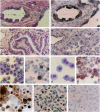Abstract
Thrombomodulin (TM) is a glycoprotein of molecular weight 75,000 kd that is normally present in restricted numbers of cells, including endothelial and mesothelial cells. In this study, the authors tested the possibility of using anti-TM to facilitate the diagnosis of mesothelioma. All of the 31 mesotheliomas and the two mesothelioma cell lines (MS-1 and MS-2) tested were stained positively with anti-TM. The specificity of anti-TM staining in mesothelioma cells was further confirmed by in situ hybridization of MS-1 cells with a TM-specific probe. The expression of TM in MS-1 cells was increased markedly when these cells were induced by 12-0-tetradecanyl phorbol 13-acetate (TPA) to differentiate. The expression of TM in mesothelioma cells, however, did not correlate with any particular phase of the cell cycle. In an attempt to differentiate pleural mesothelioma from pulmonary adenocarcinoma, the authors compared the expression of TM, carcinoembryonic antigen (CEA), and Leu M1 in these two types of tumors. Only four of 48 (8%) pulmonary adenocarcinomas were stained positively by antibodies to TM. Therefore, immunohistochemical staining with antibodies to TM yielded 100% sensitivity and 92% specificity for diagnosis of mesothelioma. All of the mesotheliomas stained negatively for CEA and Leu M1, except for one, which showed minimal focal positivity for Leu M1. In contrast, 79% and 60% of adenocarcinomas stained positively for CEA and Leu M1, respectively. These findings suggest that immunocytochemical staining with anti-TM should be added to the battery of tests to increase the diagnostic sensitivity and specificity for differentiating mesothelioma from pulmonary adenocarcinoma.
Full text
PDF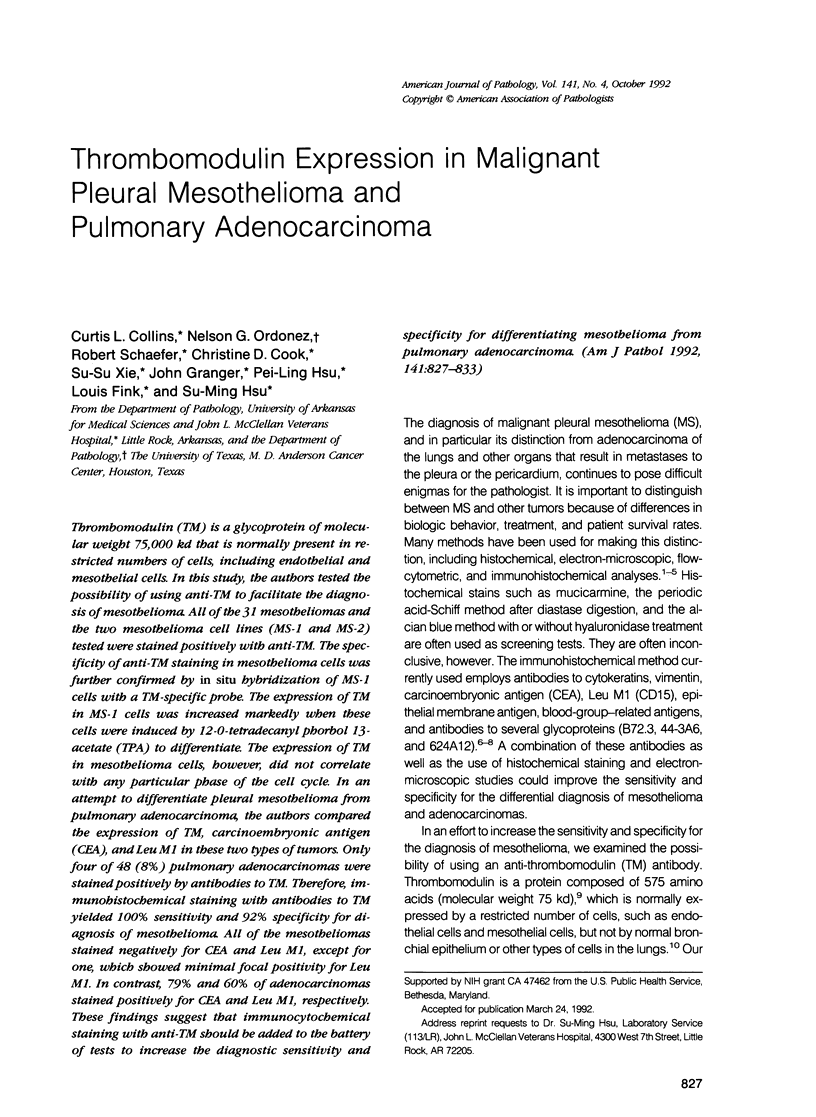
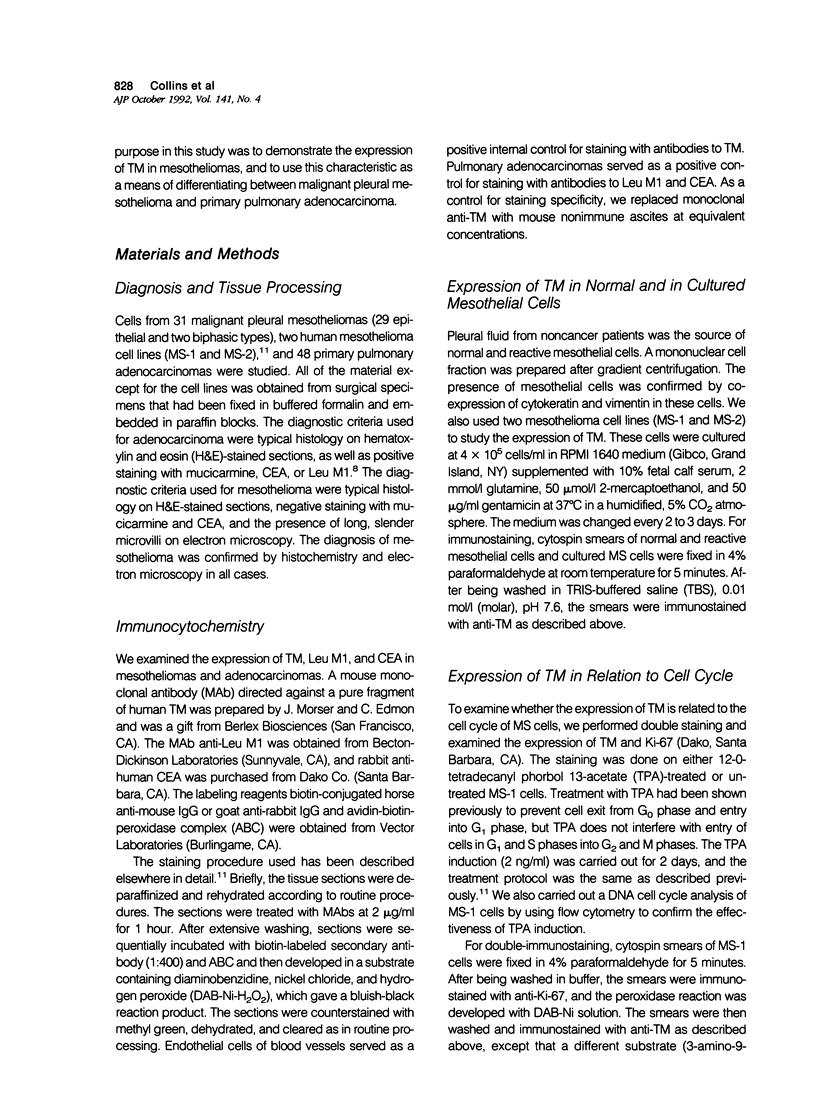
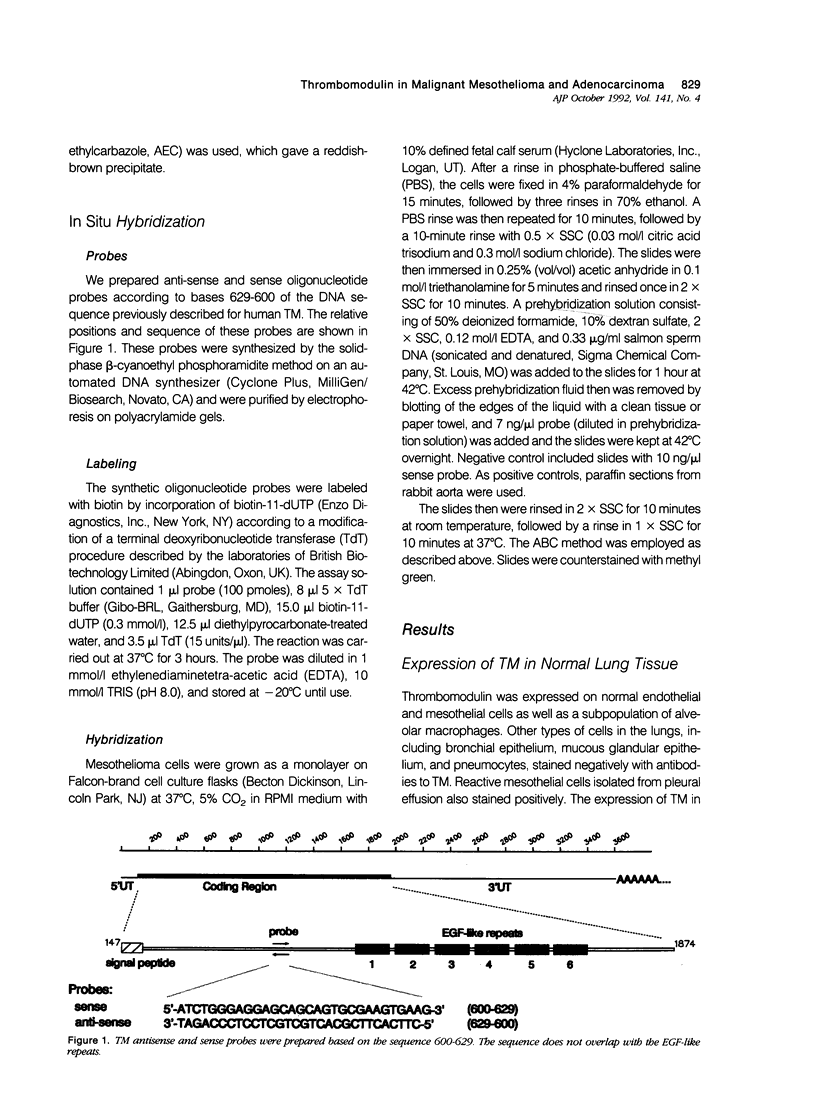
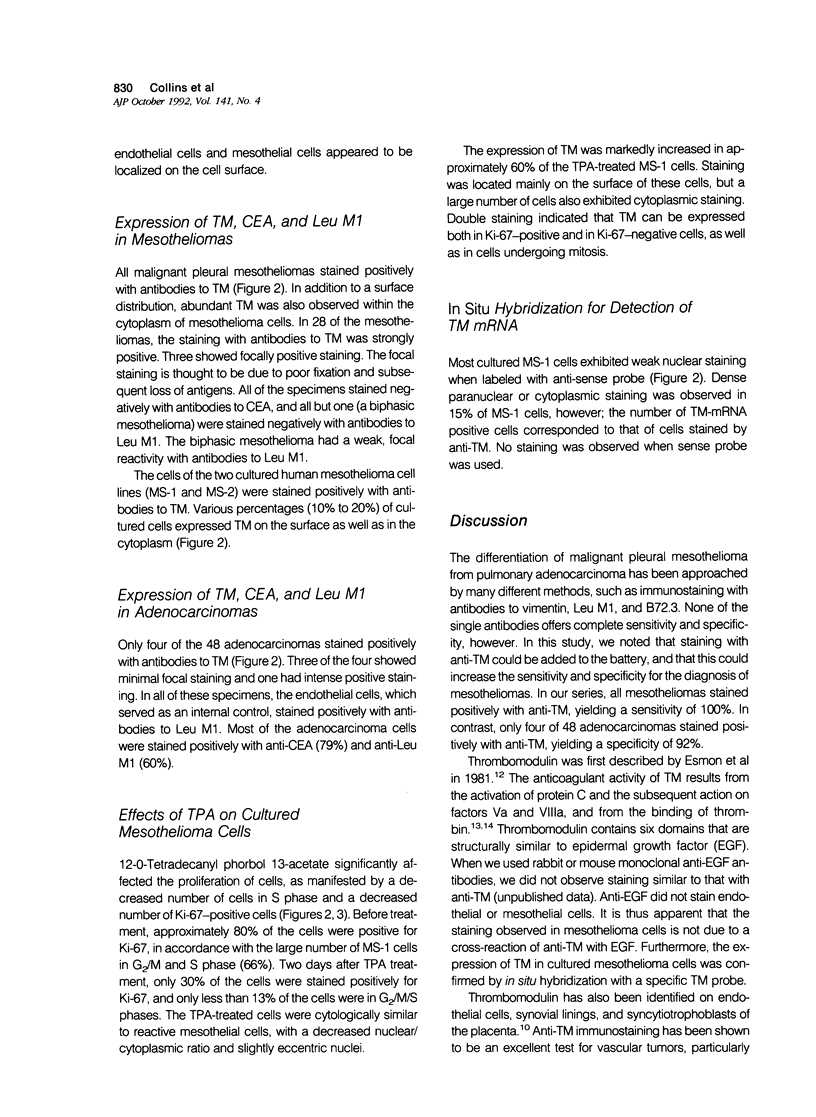
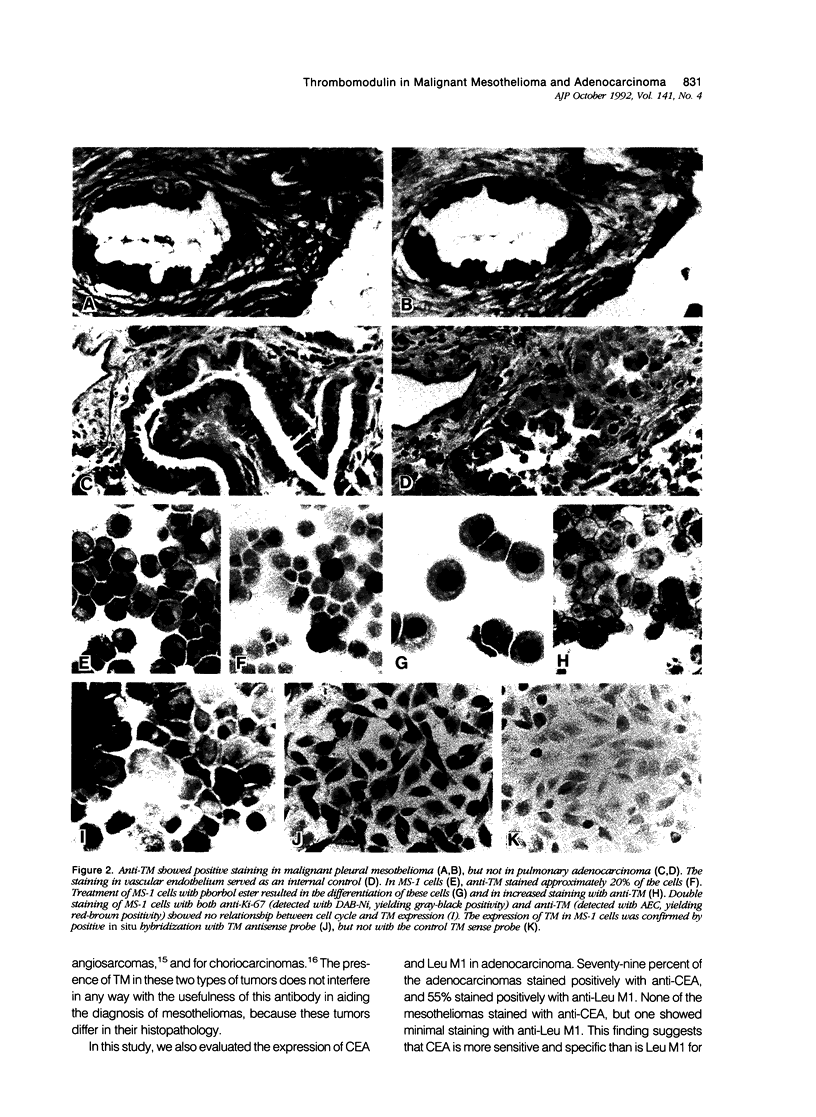
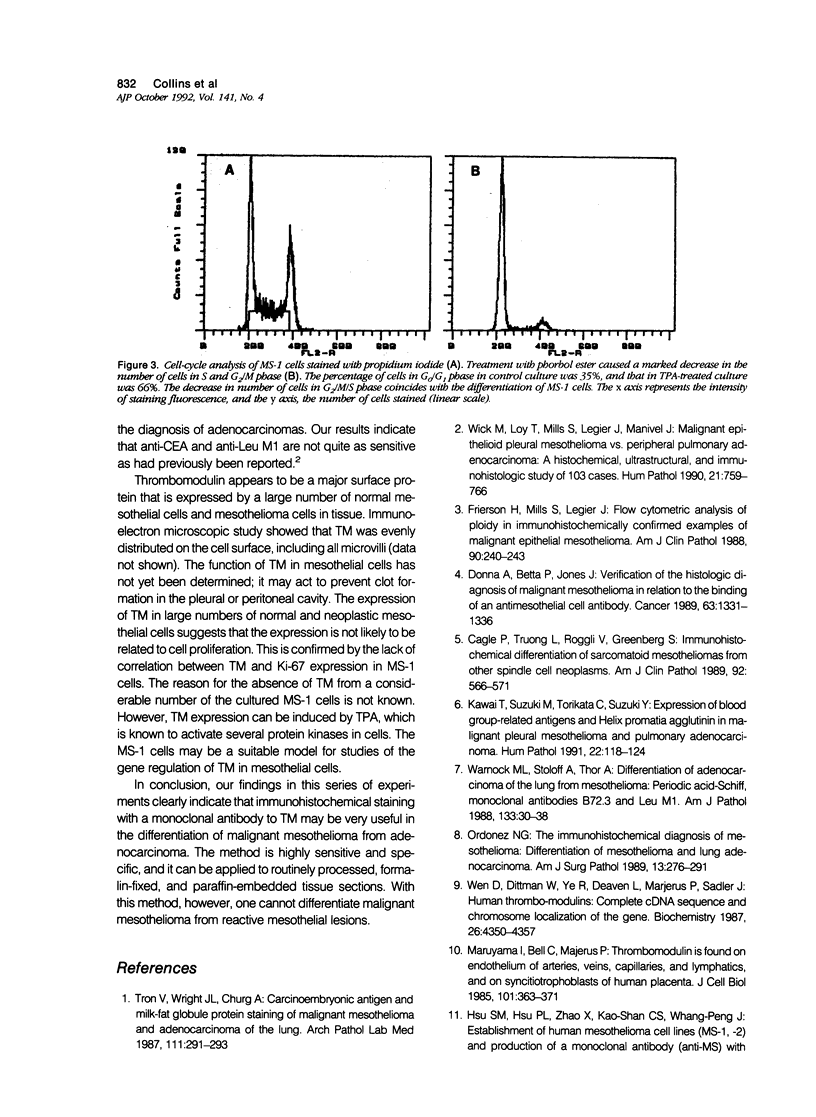
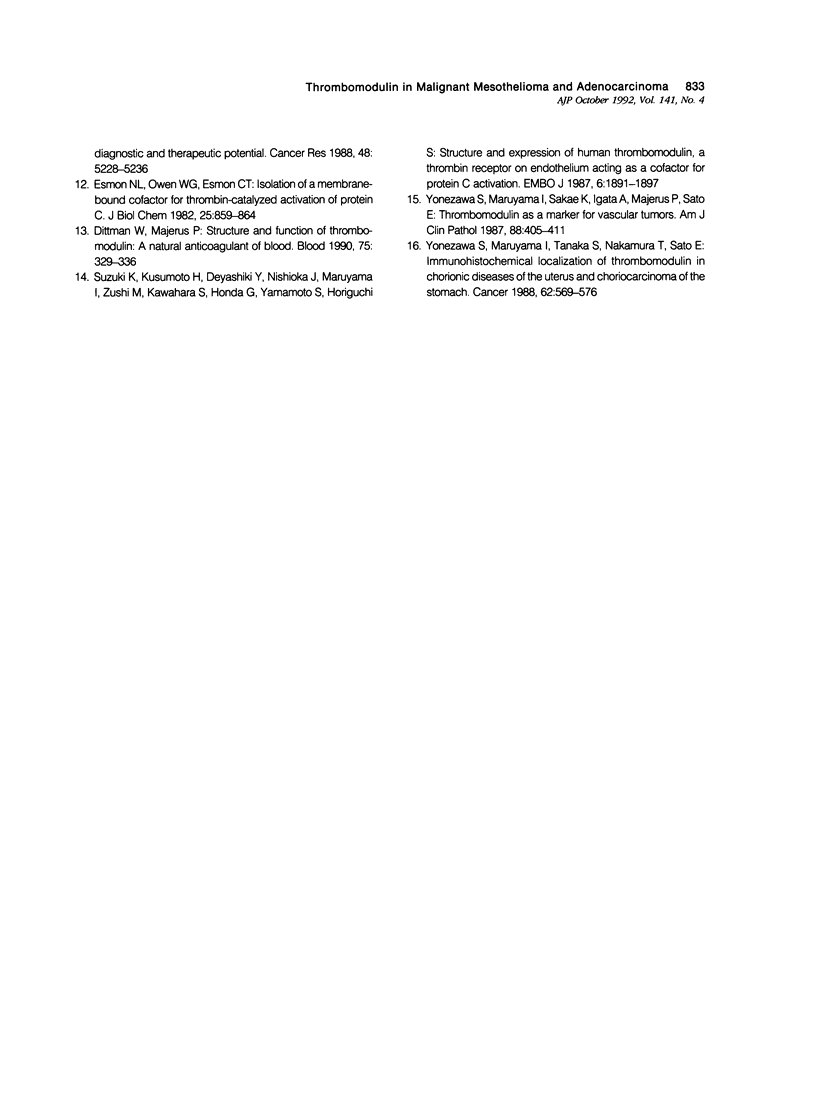
Images in this article
Selected References
These references are in PubMed. This may not be the complete list of references from this article.
- Cagle P. T., Truong L. D., Roggli V. L., Greenberg S. D. Immunohistochemical differentiation of sarcomatoid mesotheliomas from other spindle cell neoplasms. Am J Clin Pathol. 1989 Nov;92(5):566–571. doi: 10.1093/ajcp/92.5.566. [DOI] [PubMed] [Google Scholar]
- Dittman W. A., Majerus P. W. Structure and function of thrombomodulin: a natural anticoagulant. Blood. 1990 Jan 15;75(2):329–336. [PubMed] [Google Scholar]
- Donna A., Betta P. G., Jones J. S. Verification of the histologic diagnosis of malignant mesothelioma in relation to the binding of an antimesothelial cell antibody. Cancer. 1989 Apr 1;63(7):1331–1336. doi: 10.1002/1097-0142(19890401)63:7<1331::aid-cncr2820630718>3.0.co;2-3. [DOI] [PubMed] [Google Scholar]
- Esmon N. L., Owen W. G., Esmon C. T. Isolation of a membrane-bound cofactor for thrombin-catalyzed activation of protein C. J Biol Chem. 1982 Jan 25;257(2):859–864. [PubMed] [Google Scholar]
- Frierson H. F., Jr, Mills S. E., Legier J. F. Flow cytometric analysis of ploidy in immunohistochemically confirmed examples of malignant epithelial mesothelioma. Am J Clin Pathol. 1988 Sep;90(3):240–243. doi: 10.1093/ajcp/90.3.240. [DOI] [PubMed] [Google Scholar]
- Kawai T., Suzuki M., Torikata C., Suzuki Y. Expression of blood group-related antigens and Helix pomatia agglutinin in malignant pleural mesothelioma and pulmonary adenocarcinoma. Hum Pathol. 1991 Feb;22(2):118–124. doi: 10.1016/0046-8177(91)90032-k. [DOI] [PubMed] [Google Scholar]
- Maruyama I., Bell C. E., Majerus P. W. Thrombomodulin is found on endothelium of arteries, veins, capillaries, and lymphatics, and on syncytiotrophoblast of human placenta. J Cell Biol. 1985 Aug;101(2):363–371. doi: 10.1083/jcb.101.2.363. [DOI] [PMC free article] [PubMed] [Google Scholar]
- Ordóez N. G. The immunohistochemical diagnosis of mesothelioma. Differentiation of mesothelioma and lung adenocarcinoma. Am J Surg Pathol. 1989 Apr;13(4):276–291. [PubMed] [Google Scholar]
- Suzuki K., Kusumoto H., Deyashiki Y., Nishioka J., Maruyama I., Zushi M., Kawahara S., Honda G., Yamamoto S., Horiguchi S. Structure and expression of human thrombomodulin, a thrombin receptor on endothelium acting as a cofactor for protein C activation. EMBO J. 1987 Jul;6(7):1891–1897. doi: 10.1002/j.1460-2075.1987.tb02448.x. [DOI] [PMC free article] [PubMed] [Google Scholar]
- Tron V., Wright J. L., Churg A. Carcinoembryonic antigen and milk-fat globule protein staining of malignant mesothelioma and adenocarcinoma of the lung. Arch Pathol Lab Med. 1987 Mar;111(3):291–293. [PubMed] [Google Scholar]
- Warnock M. L., Stoloff A., Thor A. Differentiation of adenocarcinoma of the lung from mesothelioma. Periodic acid-Schiff, monoclonal antibodies B72.3, and Leu M1. Am J Pathol. 1988 Oct;133(1):30–38. [PMC free article] [PubMed] [Google Scholar]
- Wen D. Z., Dittman W. A., Ye R. D., Deaven L. L., Majerus P. W., Sadler J. E. Human thrombomodulin: complete cDNA sequence and chromosome localization of the gene. Biochemistry. 1987 Jul 14;26(14):4350–4357. doi: 10.1021/bi00388a025. [DOI] [PubMed] [Google Scholar]
- Wick M. R., Loy T., Mills S. E., Legier J. F., Manivel J. C. Malignant epithelioid pleural mesothelioma versus peripheral pulmonary adenocarcinoma: a histochemical, ultrastructural, and immunohistologic study of 103 cases. Hum Pathol. 1990 Jul;21(7):759–766. doi: 10.1016/0046-8177(90)90036-5. [DOI] [PubMed] [Google Scholar]
- Yonezawa S., Maruyama I., Sakae K., Igata A., Majerus P. W., Sato E. Thrombomodulin as a marker for vascular tumors. Comparative study with factor VIII and Ulex europaeus I lectin. Am J Clin Pathol. 1987 Oct;88(4):405–411. doi: 10.1093/ajcp/88.4.405. [DOI] [PubMed] [Google Scholar]
- Yonezawa S., Maruyama I., Tanaka S., Nakamura T., Sato E. Immunohistochemical localization of thrombomodulin in chorionic diseases of the uterus and choriocarcinoma of the stomach. A comparative study with the distribution of human chorionic gonadotropin. Cancer. 1988 Aug 1;62(3):569–576. doi: 10.1002/1097-0142(19880801)62:3<569::aid-cncr2820620322>3.0.co;2-t. [DOI] [PubMed] [Google Scholar]



